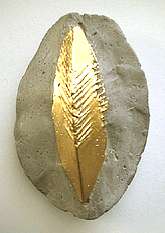
In my last post I was talking about using modelling clay as a fast and easy mold material. Here are a couple of "IDEA" pins from a series I have been working on, for a show at Shaw Jewelry Gallery. The exhibition is called "Set in Concrete" and will be the work of six jewelers who all make jewelry in concrete. It will be on July 3 to 16, in Northeast Harbor, Maine.
For this series, I used rubber letter stamps impressed in a hard modelling clay, then pressed a softer clay into that. Then I pulled the soft clay off, distorted it, sliced it up and reassembled it so it was skewed, then cast a fine concrete mix into that mold. In the one pin you can just make out little pieces of clay imbedded in the folds.
 In the black one I applied gold leaf to the recessed letters. The pin backs are two tie tacs (not shown). They are fusion welded onto thin bronze strips that are cast just below the back surface.
In the black one I applied gold leaf to the recessed letters. The pin backs are two tie tacs (not shown). They are fusion welded onto thin bronze strips that are cast just below the back surface.
